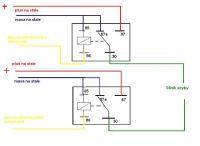Welcome gentlemen.
I have such a problem. I wanted to install el. windows for my Mercedes Atego. That's why I bought motors, a switch and later relays. I installed everything and it turned out to be working ... until I tried to close the glass completely. Then the relay burned out, i.e. the contacts welded together. I replaced the relays for 60A and everything worked again until I started the engine. Then the 15A fuse blown, I put a stronger fuse, i.e. 20A, then the relay was welded again. (Pin 30 87a My motors are connected as follows:
The motors have two pins with alternating mass, the window controller + goes to the coil, relays first type 571 and then the same scheme only 60A. My question ? There are also relays with a resistor https://www.buycarparts.co.uk/herthbuss-elparts/7548806. can this resistor change something, because it is on a coil that does not burn out. Thanks for the answer. PS The relays / fuses are blown in the end positions of the glass, i.e. when the engine cannot continue to run.
I have such a problem. I wanted to install el. windows for my Mercedes Atego. That's why I bought motors, a switch and later relays. I installed everything and it turned out to be working ... until I tried to close the glass completely. Then the relay burned out, i.e. the contacts welded together. I replaced the relays for 60A and everything worked again until I started the engine. Then the 15A fuse blown, I put a stronger fuse, i.e. 20A, then the relay was welded again. (Pin 30 87a My motors are connected as follows:

The motors have two pins with alternating mass, the window controller + goes to the coil, relays first type 571 and then the same scheme only 60A. My question ? There are also relays with a resistor https://www.buycarparts.co.uk/herthbuss-elparts/7548806. can this resistor change something, because it is on a coil that does not burn out. Thanks for the answer. PS The relays / fuses are blown in the end positions of the glass, i.e. when the engine cannot continue to run.


